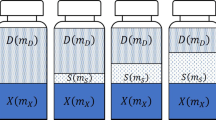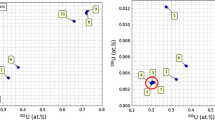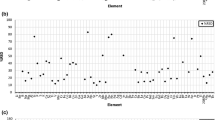Abstract
Samples of materials involved in the conversion of uranium into nuclear-grade products are collected to support the verification of States’ declarations and to look for indications of possible undeclared materials and activities. Samples are analysed by several laboratories to determine concentrations of about sixty impurities; the data consistency is addressed through the unified reporting requirements, the use of common reference materials, and via inter-laboratory comparisons. The impurity analysis results, along with other essential parameters, are interpreted to judge sample conformity to the relevant specifications, to evaluate the facility design information, to assess material provenance and intended use.
Similar content being viewed by others
References
IAEA statute, amended (1989) articles XII.A, XX
IAEA (1972) The structure and content of agreements between the agency and states required in connection with the Treaty on Non-Proliferation of Nuclear Weapons. INFCIRC/153 (corrected): articles 2, 34, 112
IAEA (1997) Model protocol additional to the agreement(s) between state(s) and the International Atomic Energy Agency for the application of safeguards. INFCIRC/540 (corrected): article 2.a(vi)
ASTM C967-13 (2013) Standard specification for uranium ore concentrate
ASTM C753-04 (2009) Standard specification for nuclear-grade sinterable uranium dioxide powder
ASTM C788-03 (2009) Standard specification for nuclear-grade uranyl nitrate solution or crystals
ASTM C1233-09 (2009) Standard practice for determining equivalent boron contents of nuclear materials
ASTM C787-11 (2011) Standard specification for uranium hexafluoride for enrichment
ASTM C1287-10 (2010) Standard test method for determination of impurities in nuclear grade uranium compounds by inductively coupled plasma mass spectrometry
De Souza AL, Cotrim MEB, Pires MAF (2013) An overview of spectrometric techniques and sample preparation for the determination of impurities in uranium nuclear fuel grade. Microchem J 106:194–201
Varga Z, Katona R, Stefánka Z, Wallenius M, Mayer K, Nicholl A (2010) Determination of rare-earth elements in uranium-bearing materials by inductively coupled plasma mass spectrometry. Talanta 80:1744–1749
IAEA SG-PR-12135 (2013) Data reporting requirements for laboratory analysis results of characterization of uranium material samples
Bürger S, Boulyga SF, Peńkin MV, Bostick D, Jovanovic S, Lindvall R, Rasmussen G, Riciputi L (2014) Quantifying multiple trace elements in uranium ore concentrates: an interlaboratory comparison. J Radioanal Nucl Chem 301:711–729
LMA report under Russian Support Programme to IAEA Safeguards, task A1873 (2012) Experimental investigation of trace element behaviour in uranium compounds during the concentration and conversion
CNSC report under Canadian Support Programme to IAEA Safeguards, task A1796 (2013) Behavior of trace elements during the refining and conversion of uranium
South African Support Programme to IAEA Safeguards. Task A1790: experimental investigation of behaviour of trace elements in uranium during the concentration processes
Button P, Healey G, Chipley D (2013) Change in impurities observed during the refining and conversion processes. ESARDA Symposium, Bruges
JRC Tech Report under European Commission Support Programme to IAEA Safeguards, task A1753 (2014) Conclusions on the impurity propagation in the course of uranium ore concentrate production
US Support Programme to IAEA Safeguards. Task A1948: experimental investigation of behaviour of trace elements in uranium during the concentration and conversion processes
Support Programmes to IAEA Safeguards. Tasks UK A1968, EC A1967, USA A1973: Analysis results and metadata for the Springfields UOC sample collection
Varga Z, Wallenius M, Mayer K (2010) Origin assessment of uranium ore concentrates based on their rare-earth elemental impurity pattern. Radiochim Acta 98:771–778
Varga Z, Wallenius M, Mayer K, Meppen M (2011) Analysis of uranium ore concentrates for origin assessment. Proc Radiochim Acta 1:1–4
Peńkin MV, Zhao K, Fischer DM, Boulyga SF (2012) Use of rare-earth elemental impurity patterns for origin assessment of uranium materials. In: 9th international conference on methods and applications of radioanalytical chemistry (MARC IX), Kailua-Kona
Keegan E, Kristo M, Colella M, Robel M, Williams R, Lindvall R, Eppich G, Roberts S, Borg L, Gaffney A, Plaue J, Wonga H, Davis J, Loi E, Reinhard M, Hutcheon I (2014) Nuclear forensic analysis of an unknown uranium ore concentrate sample seized in a criminal investigation in Australia. Forensic Sci Int 240:111–121
Zhao K, Ryzhinsky M, Peńkin M (2010) Statistical evaluation of trace element analysis data in nuclear safeguards. In: 7th winter sympsium on chemometrics (WSC 7), St. Petersburg
Richter S, Kühn H, Aregbe Y, Hedberg M, Horta-Domenech J, Mayer K, Zuleger E, Bürger S, Boulyga S, Köpf A, Poths J, Matthew K (2011) Improvements in routine uranium isotope ratio measurements using the modified total evaporation method for multi-collector thermal ionization mass spectrometry. J Anal At Spectrom 26:550–564
Robel M, Kristo MJ, Heller MA (2009) Nuclear forensic inferences using multidimensional statistics. In: 50th annual meeting of the Institute of Nuclear Materials Management (INMM), Tucson
Robel M, Hutcheon ID, Kristo MJ, Borg LE, Ramon EC, Williams RW, Lindvall RE, Gaffney AM, Genetti V (2011) The uranium sourcing database project: a comprehensive international nuclear forensics collaboration from ore to attribution. In: 52nd annual meeting of the Institute of Nuclear Materials Management (INMM), Desert Springs
US Support Programme to IAEA Safeguards. Task A1975: provision of stand-alone version of DAVE software for evaluation of trace element and isotopic signatures in uranium samples
Author information
Authors and Affiliations
Corresponding author
Rights and permissions
About this article
Cite this article
Peńkin, M.V., Boulyga, S.F. & Fischer, D.M. Application of uranium impurity data for material characterization in nuclear safeguards. J Radioanal Nucl Chem 307, 1995–1999 (2016). https://doi.org/10.1007/s10967-015-4380-2
Received:
Published:
Issue Date:
DOI: https://doi.org/10.1007/s10967-015-4380-2




